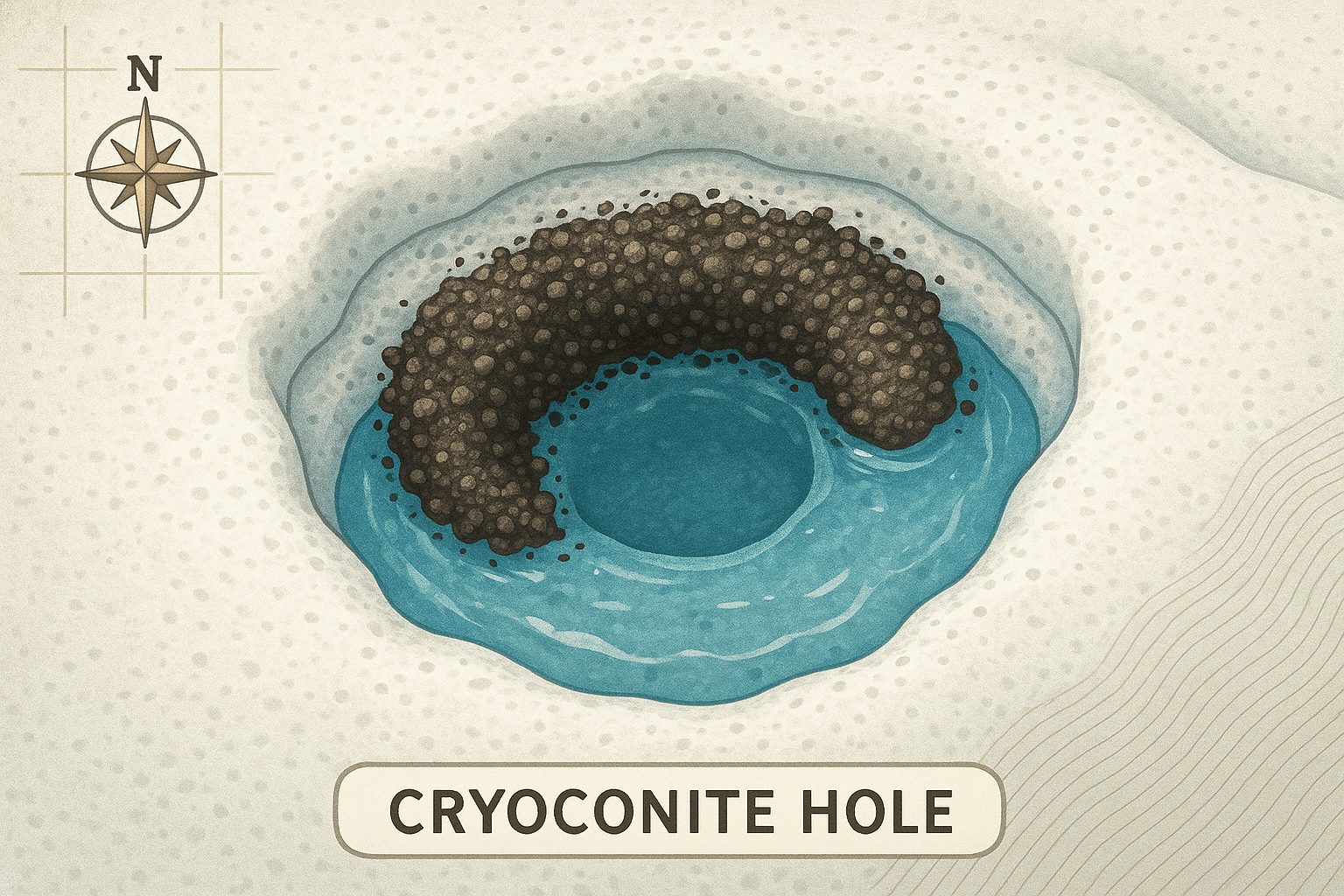What Exactly is Cryoconite?
The name “cryoconite” comes from the Greek words kryos (cold) and konis (dust), literally meaning “cold dust.” It’s a fitting name for this granular, dark-coloured sediment that is found on glaciers and ice sheets across the globe, from the polar regions of Greenland and Antarctica to the high-altitude glaciers of the Himalayas and the Andes.
But what is it made of? Cryoconite is a fascinating and complex aggregate:
- Mineral Dust: Tiny rock particles and minerals blown by the wind, sometimes from thousands of miles away. Dust from deserts like the Sahara or the Gobi can travel on atmospheric currents and eventually settle on the Greenland Ice Sheet.
– Soot and Black Carbon: Particles from the incomplete combustion of fossil fuels, industrial pollution, and distant wildfires get transported and deposited on the ice.
– Biological Material: This is where it gets truly interesting. Cryoconite is bound together by a community of living microorganisms, forming a self-sustaining ecosystem.
These components are swept onto the glacier surface. Because the dark particles are much less reflective than the surrounding white ice, they absorb more solar radiation. This energy melts the ice directly beneath them, forming a small, water-filled pocket in the glacier’s surface. This is a cryoconite hole—a tiny, insulated oasis and the crucible for life on ice.
A Micro-Oasis: Life in a Cryoconite Hole
A cryoconite hole is a world unto itself. While the glacier surface might be a frigid -15°C (5°F), the water inside the hole, warmed by the dark sediment, hovers just above freezing at 0°C (32°F). This liquid water environment, protected from the wind and bathed in sunlight, becomes a perfect habitat for some of the planet’s toughest organisms.
Within this granular matrix, a simple but effective food web emerges:
- Primary Producers: The foundation of the ecosystem is built by photosynthetic bacteria, primarily cyanobacteria (once called blue-green algae). They use sunlight to create energy, and in the process, they secrete sticky substances (extracellular polymeric substances) that bind the mineral and soot particles together, creating the cohesive granules we call cryoconite.
- Primary Consumers: Grazing on this bounty of cyanobacteria are microscopic animals. The most famous residents are tardigrades, also known as “water bears.” These eight-legged invertebrates are legendary extremophiles, capable of surviving freezing, dehydration, and even the vacuum of space. Here, they are simply part of the community, feeding and reproducing in their watery home. They are joined by other tiny grazers like rotifers.
- Decomposers: A host of other bacteria and fungi work to break down waste products and dead organisms, recycling crucial nutrients like nitrogen and phosphorus back into the ecosystem, ensuring its continued survival.
This community is so effective that cryoconite holes are considered hotspots of biodiversity and biogeochemical activity on otherwise barren ice surfaces.
The Dark Side of Life: How Cryoconite Accelerates Glacier Melt
Herein lies the great paradox of cryoconite. This tiny, life-sustaining ecosystem has a colossal impact on its glacial home, and it’s not a positive one for the ice. The key geographical concept at play here is albedo.
Albedo is a measure of how much solar radiation a surface reflects. Bright, white snow and ice have a high albedo—they reflect most of the sun’s energy back into space, which helps keep the glacier cool. Dark cryoconite, on the other hand, has a very low albedo. It absorbs sunlight efficiently, converting it into heat.
As cryoconite forms and spreads, it creates a “biological darkening” effect on the glacier’s surface. More dark patches mean less reflectivity and more heat absorption across the entire ice surface. This creates a dangerous feedback loop:
- Cryoconite melts into the ice, creating stable, watery habitats.
- More life grows in these habitats, producing more dark, biological material.
- The glacier surface becomes progressively darker, lowering its overall albedo.
- The darker surface absorbs more heat, leading to faster melting.
- Faster melting can expose more cryoconite and create more surface water, further encouraging biological growth.
Scientists studying the Greenland Ice Sheet have identified this bio-albedo feedback as a critical factor in its accelerated melt. The “dark zone” on the margin of the ice sheet, an area covered in cryoconite and algae, is melting significantly faster than cleaner parts of the ice, contributing directly to global sea-level rise.
A Global Phenomenon with Human Consequences
The impact of cryoconite is not just an abstract scientific curiosity; it has profound implications for human geography.
In the Himalayas, often called the “Third Pole”, glaciers are a vital source of freshwater for nearly two billion people across countries like India, China, Nepal, and Pakistan. These glaciers feed Asia’s great rivers, including the Indus, Ganges, and Brahmaputra, supporting agriculture, providing drinking water, and powering hydroelectric dams. The accelerated melt of these glaciers, partly driven by deposits of cryoconite and black carbon from regional air pollution, threatens the long-term water security of this entire region. While the initial melt may increase river flows, the eventual shrinking of these glacial “water towers” could lead to severe shortages.
Meanwhile, the darkening and rapid melt of the Greenland Ice Sheet is a primary driver of modern sea-level rise, posing a direct threat to coastal cities and communities worldwide, from Miami to Mumbai to Shanghai.
A Tiny World with a Giant Footprint
Cryoconite challenges our perception of glaciers as static, lifeless places. It reveals them to be dynamic landscapes hosting unique ecosystems. Yet, it also serves as a powerful reminder of the intricate connections that govern our planet.
The dust from a distant desert, the soot from a city, and the resilience of a microscopic water bear all converge on a sheet of ice. Together, they form a living community that, in a twist of fate, accelerates the destruction of its own fragile habitat. Understanding cryoconite is no longer just a niche interest for glaciologists; it’s a crucial piece of the puzzle in predicting the future of our planet’s ice, its water resources, and its coastlines.
